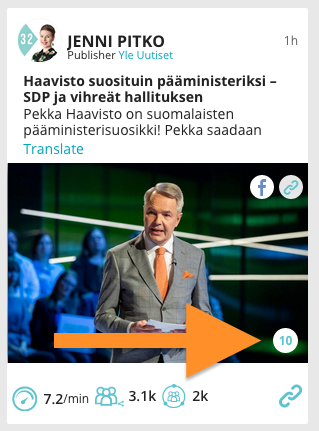Around election times, monitoring politicians on social media comes to the forefront. We analysed in the past how creating buzz on social has helped or harmed political candidates in the United States, France, and Finland.
This spring, we’ve taken unprecedented effort to capture the entire spectrum of political hopefuls by adding almost 1000 candidates into our election filter. There are party leaders and official party pages, plus virtually everyone with a public page on Facebook, Twitter, or Instagram who is running for a seat in the Finnish parliament this spring. (Over 400 candidates have no public pages on social media at all.)
You can find both filters in Trending: Eduskuntavaalit 2019, Eduskuntavaalit Puoluejohtajat 2019.
How to make sense of filters where you’re tracking politicians?
1. Quickly see which politician’s own posts are noticed on social media.
What might be surprising is that it’s not always party leaders who get the most engagement. Social media candidates with only a few thousand followers can generate buzz with an opinion, a question, or the right image or video that resonate with their audience.
One candidate shared a picture of flowers announcing her pregnancy and thanking her supporters.
Another candidate posted a video of himself in the forest talking about the environment.
Yet another candidate shared a meme-style photo of a political opponent with a long comment highlighting his campaign promises.
These personalised posts often draw more engagement than re-shares of media articles.
A surprising but not unique to Finland point is the low use of Instagram among political candidates. Whether it’s the generation gap, or the perception that Facebook is where most voters still are, very few politicians take to the platform for campaigning.
While engagement on Instagram on average is lower than on Facebook, it does have the advantage of reaching younger audiences. Which politicians are trying to capture those?
Pro Tip: You can zoom in on the politician’s Instagram posts by selecting “only posted on Instagram” from the left side panel.
2. See which media articles politicians find important.
Politicians often share articles that highlight issues they’re campaigning for, adding their own take and generating further buzz. Stories on taxation, health-care, and immigration draw social media commentary from across the spectrum.
When you’re in Realtime, pay attention to the number of social posts any storycard has, highlighted below. Then click on the image to get the view of every public social account that re-shared that article.

If you’re browsing in another tab, you can easily check which politicians re-shared your story with our Chrome Extension.
Pro Tip: Order your political filter by Over Performing to see posts that are bubbling under.
Will any of the social discussion have an impact on the outcome of the elections? It’s hard to predict, but we have seen in the past winning political candidates attracting higher rates of social engagement than their less successful counterparts.
Need help tracking political candidates? Get in touch with us [email protected].
